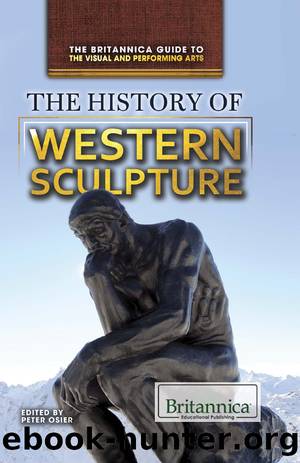The History of Western Sculpture by Peter Osier

Author:Peter Osier
Language: eng
Format: epub
ISBN: 9781680480870
Publisher: Britannica Educational Publishing
Published: 2015-08-07T00:00:00+00:00
INTERNATIONAL GOTHIC
The plastic arts are harder to understand in this period, because so much has been destroyed. For example, enormous quantities of goldsmithsâ work owned by the French royal family have vanished. A few of the remaining pieces testify to the quality of the work, which is beautifully finished and gaily coloured in the technique of en ronde bosse enameling.
More seriously, large quantities of private monumental sculpture have been lost in France and the Low Countries. The main sculptor of the French royal family in the second half of the 14th century was André Beauneveu. His reputation was so widespread that he earned a mention by Jean Froissart, the medieval poet and court historian whose Chronicles of the 14th century remain the most important and detailed document of feudal times in Europe and the best contemporary exposition of chivalric and courtly ideals. Beauneveu produced a large number of monuments, especially for King Charles V, of which several effigies survive.
Claus Sluter worked for Charles Vâs brother Philip the Bold, duke of Burgundy. Sluterâs surviving work is mainly at Dijon, France, where he was active from about 1390 to about 1406. His figure style is very strongly characterized and detailed and, at times, emotional. This suggests that his origins are German and that he may have come from the region of Westphalia. The intrusive realism of Sluterâs work, however, is also symptomatic of a gradual change in sculptural style during this period. The strong characterization of the faces of his figures finds parallels in the near-contemporary triforium busts and PrÌemyslid tombs in St. Vitusâs Cathedral in Prague. Sluterâs drapery style, which veers dramatically away from the somewhat reticent elegance of previous court sculpture, also has parallels in the east. Bohemia and Austria possess a series of Madonna figures (Schöne Madonnen) swathed in extremely elaborate and artificial drapery arrangements.
England stands apart from much of the development represented by Sluterâs style. The royal tombs in Westminster Abbey, which extend up to Richard II (died 1400), do not reflect changes subsequent to the phase of Beauneveu. Further, a fashion for bronze effigies, going back to the effigy of Henry III (1291â93), persisted in England.
Download
This site does not store any files on its server. We only index and link to content provided by other sites. Please contact the content providers to delete copyright contents if any and email us, we'll remove relevant links or contents immediately.
Rule by Jay Crownover(2627)
The Meaning of the Library by unknow(2472)
Fierce by Aly Raisman(2122)
Our World by Mix Little(1798)
Star Wars The Rise of Skywalker The Visual Dictionary by Pablo Hidalgo(1786)
Fashion 101 by Erika Stalder(1755)
DRAW: A Fast, Fun & Effective Way to Learn by Jake Spicer(1531)
The Hunger Games: Official Illustrated Movie Companion by Egan Kate(1363)
Charlie and the Chocolate Factory (Puffin Modern Classics relaunch) by Roald Dahl(1348)
Beyond the Dance by Chan Hon Goh(1297)
Monster Book of Manga Drawing by David Okum(1239)
Forward: A Memoir by Abby Wambach(1179)
1787 by Nick Brodie(1171)
The Maddie Diaries by Maddie Ziegler(1170)
Origami for Children by Mari Ono(1123)
Friends Lovers and Family by Unknown(1119)
Harlem Stomp! by Laban Carrick Hill(1094)
Thirteen by Kelley Armstrong(1093)
Ashes and Ice by Rochelle Maya Callen(1091)
